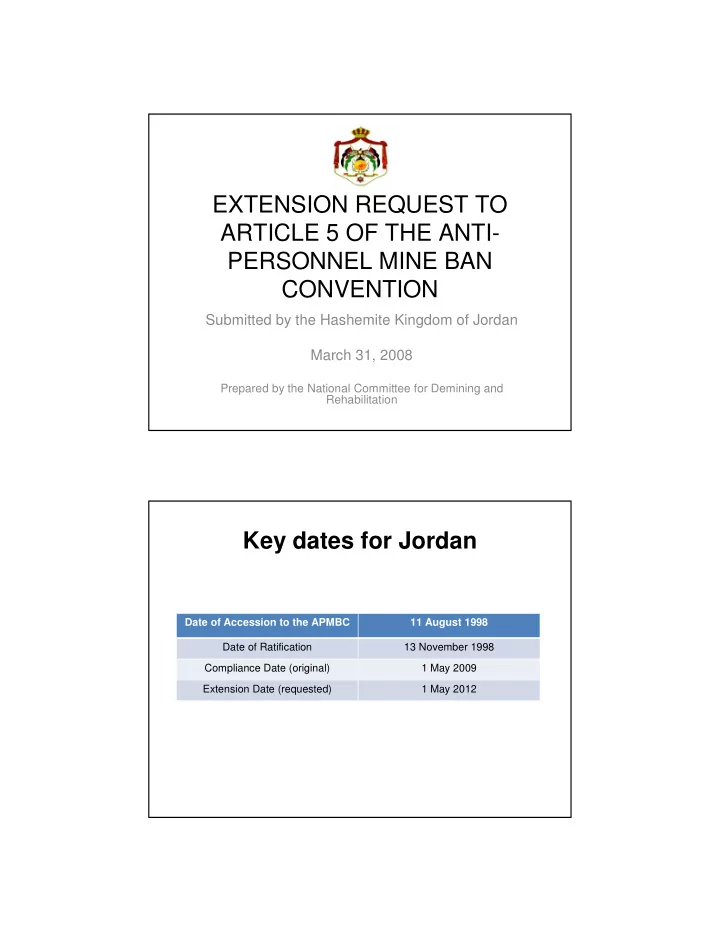

EXTENSION REQUEST TO ARTICLE 5 OF THE ANTI- PERSONNEL MINE BAN CONVENTION Submitted by the Hashemite Kingdom of Jordan March 31, 2008 Prepared by the National Committee for Demining and Rehabilitation Key dates for Jordan Date of Accession to the APMBC 11 August 1998 Date of Ratification 13 November 1998 Compliance Date (original) 1 May 2009 Extension Date (requested) 1 May 2012
Origins of the Article 5 Implementation Challenge The presence of landmines on Jordanian territory can be traced back to four distinct periods: I. The War of 1948 and partition of Palestine II. The period of Arab-Israeli conflict (1967-1969) III. Internal conflicts in the early 1970s IV. Hostilities with Syria in 1975 The spatial distribution of the minefields emanating from these episodes was limited to the following areas: • North Border • JordanValley • Wadi Araba/Aqaba Location of Jordan’s Minefields
Nature and Extent of the Original Article 5 Implementation Challenge In 1993 His Late Majesty King Hussein Bin Talal directed the Royal Engineering Corps to begin demining operations. Original estimation of the problem: • 60 million m² of SHA • 500 minefields • 305,000 mines • 216,000 APMs • 89,000 AVMs Original Estimation of the Problem (1993) Origin SHAs APMs AVMs MFs Jordan 48 mil m² 151,028 80,500 367 Israel 12 mil m² 64,802 8,323 133 Total 60 mil m² 215, 830 88,823 500
Qualitative Nature of the Challenge • 500,000 people representing 8% of the population impacted by the presence (or suspected presence) of mines along Jordan’s western borders • 755 reported accidents (640 survivors, 115 fatalities) between 1948 and 2007 • Several ‘poverty-pockets’ located in some of the most mine-affected communities in the country Jordan Mine Action Governance Structure
Nature and Extent of Progress Made Quantitative Progress (1993-2008) • 129,800 APMs were removed • 41,897 AVMs and approximately 40,000 UXOs removed • 16 million m² were cleared • 34 million m² was cancelled through NCDR’s land release program • Approx. 10 million m² along the northern border containing close to 136,000 landmines left to be cleared. • Recent progress has demonstrated a positive upturn in outputs. Between 2005 and 2007, Jordan made impressive strides in reducing its landmine threat. • Based on innovative thinking and the adoption of a risk management approach to releasing land, scarce resources – time, money, demining assets – have been used to maximum effect: Over the past 2 years the REC and NPA have collectively lifted 68,515 mines and cleared an area of o 14.4 million m². Quantifiable Progress 1993 - 2008
Circumstances that impeded compliance in the 10 year period Several elements have contributed to Jordan’s inability to meet its 10-year compliance obligations under Article 5; namely: • Mine Action was orchestrated solely by the military during the early years • No effective ‘Mine Action Authority’ existed till 2004 • Big increase in partnerships occurred only after 2004 • Technical reasons such as flooding and soil erosion slowed down the process • Northern Border Mine Belt was left till the end due to its complexity & difficulty Jordan Minefield Situation 2008
What Work Remains: Northern Border Project • The NBP is the last major demining-task remaining in Jordan • Full clearance operations commenced on 1 April 2008 • Total area approx. 10 million m² • Total number of mines: 136,570 92,569 APMs o 44,001 AVMs o • The SHA stretches for 104 km along the Northern border • According to LRS 69,000 people impacted • The NBP’s planned budget of $13 million has been mobilized through contributions from Australia, Canada, EC, Germany, Japan, and Norway • NCDR manages the Northern Border Project and provides QM over the demining process which is being implemented by NPA. The REC lends EOD support and is responsible for constructing the replacement border security system. • NPA executes the demining of the MFs in accordance with the NTS&Gs and NCDR provides external quality management.
Time Requested Jordan has requested an extension of 36 beginning 1 May 2009 and months terminating on 1 May 2012. Thank you for your attention For more information please visit www.ncdr.org.jo
Recommend
More recommend